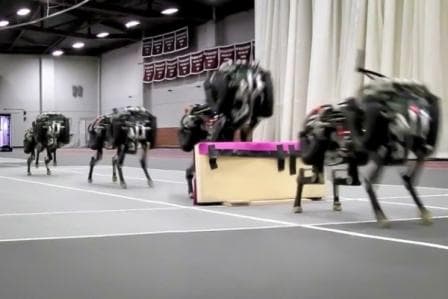MIT’s Cheetah Is Now Able To Jump Obstacles On Its Own
Remember MIT’s terrifying quadruped robot <a href="https://www.crazyengineers.com/threads/cheetah-robot-is-just-as-efficient-as-cheetah.67124">Cheetah Robot Is Just As Efficient As Cheetah!</a>? Well its creators have given it a new capability that makes it the only robot in the world that can run and jump obstacles autonomously without a tether. The Cheetah is now able to perform running jumps over obstacles that measure more than half its own height (up to 18 inches) while running at a constant speed of 5 miles per hour. So how does the Cheetah perform this extraordinary feat? Well, it takes its inspiration from humans. When the Cheetah is on the run and it detects an obstacle it estimates the object’s height and distance and jumps precisely at the correct movement with a calculated force that helps it land on the other side. While that was the concise and non-scientific answer for the question, in the next paragraph we explain it in detail.

As you know the autonomous MIT Cheetah finds its way across a terrain using LIDAR. The team led by Sangbae Kim, an assistant professor of mechanical engineering at MIT used this LIDAR data to develop a three part algorithm for the running jump. The first part of the program allows the Cheetah to “see†the obstacle and estimate its size. The MIT Cheetah sees the ground as a straight line and any obstacles count as deviations from the line. The researchers developed a mathematical formula that helps the Cheetah to calculate the height and distance of the upcoming obstacle in real time. The second part of the algorithm deals with the approach. The LIDAR data is used again by the Cheetah to find the best position that will help it jump across the hurdle safely. The Cheetah even programs its stride that is to be executed after the jump. All this takes place in the brain of the Cheetah in less than 100 milliseconds which is about half the time it takes to complete a single stride. Once it has fixed the jump point, the third part of the algorithm kicks in that helps it calculate the force it requires to make the jump.
The team says from an engineering perspective the jumps are not optimal but feasible in nature. If they had wanted to optimise energy efficiency of every jump for saving fuel, the jumps would have been extremely dangerous as they would have required the Cheetah to jump at the last moment at a height that just clears the obstacle. The team tested the Cheetah’s capability on treadmill where it was tethered and on a track where it was un-tethered. The treadmill run was a daunting task for the Cheetah because the treadmill track was only 4 meters long and the robot had a 1 meter of run to detect, jump and clear obstacles. MIT’s Cheetah managed to clear 70% of the obstacles in that test. During the un-tethered run on track the success rate rose to 90 percent. The team is now planning to program the Cheetah to perform running jumps on softer terrain such as a grassy field.
Source: #-Link-Snipped-#

As you know the autonomous MIT Cheetah finds its way across a terrain using LIDAR. The team led by Sangbae Kim, an assistant professor of mechanical engineering at MIT used this LIDAR data to develop a three part algorithm for the running jump. The first part of the program allows the Cheetah to “see†the obstacle and estimate its size. The MIT Cheetah sees the ground as a straight line and any obstacles count as deviations from the line. The researchers developed a mathematical formula that helps the Cheetah to calculate the height and distance of the upcoming obstacle in real time. The second part of the algorithm deals with the approach. The LIDAR data is used again by the Cheetah to find the best position that will help it jump across the hurdle safely. The Cheetah even programs its stride that is to be executed after the jump. All this takes place in the brain of the Cheetah in less than 100 milliseconds which is about half the time it takes to complete a single stride. Once it has fixed the jump point, the third part of the algorithm kicks in that helps it calculate the force it requires to make the jump.
The team says from an engineering perspective the jumps are not optimal but feasible in nature. If they had wanted to optimise energy efficiency of every jump for saving fuel, the jumps would have been extremely dangerous as they would have required the Cheetah to jump at the last moment at a height that just clears the obstacle. The team tested the Cheetah’s capability on treadmill where it was tethered and on a track where it was un-tethered. The treadmill run was a daunting task for the Cheetah because the treadmill track was only 4 meters long and the robot had a 1 meter of run to detect, jump and clear obstacles. MIT’s Cheetah managed to clear 70% of the obstacles in that test. During the un-tethered run on track the success rate rose to 90 percent. The team is now planning to program the Cheetah to perform running jumps on softer terrain such as a grassy field.
Source: #-Link-Snipped-#
0
